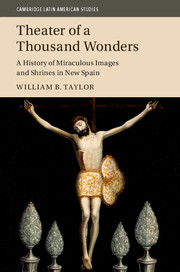Book contents
- Frontmatter
- Dedication
- Contents
- List of Figures
- List of Maps
- List of Tables
- Preface and Acknowledgments
- Archive Abbreviations
- Introduction
- Part I Bearings: Historical Patterns and Places of Image Shrines
- Part II Soundings: Divine Presence, Place, and the Power of Things
- Conclusion
- Appendix 1 Colonial Image Shrines
- Appendix 2 When Shrines Began
- Appendix 3 Other Saints
- Index
Preface and Acknowledgments
Published online by Cambridge University Press: 05 September 2016
- Frontmatter
- Dedication
- Contents
- List of Figures
- List of Maps
- List of Tables
- Preface and Acknowledgments
- Archive Abbreviations
- Introduction
- Part I Bearings: Historical Patterns and Places of Image Shrines
- Part II Soundings: Divine Presence, Place, and the Power of Things
- Conclusion
- Appendix 1 Colonial Image Shrines
- Appendix 2 When Shrines Began
- Appendix 3 Other Saints
- Index
Summary
This study of sacred images, shrines, and devotion in New Spain began with two puzzles about Mexico's celebrated Virgin of Guadalupe. First, by the late colonial period Guadalupe seemed to be known and revered almost everywhere yet drew few long-distance pilgrims to the shrine at Tepeyac and its precious matrix image; and, second, devotion to Guadalupe continued to grow and prosper when other image shrines are thought to have been in decline, shadowed by early signs of modernization and creeping disenchantment. It became clear to me that these puzzles and the history of devotion to this image and shrine more broadly could best be addressed as part of a larger story of European Catholic Christianity becoming an American religion in which hundreds of celebrated image shrines with followings beyond their immediate vicinity flowed into a deep river of devotion. Finding that few of those shrines declined during the eighteenth and nineteenth centuries led beyond the Virgin of Guadalupe to other questions. How and when did the many shrines develop? Why have so many of them lasted so long? How did devotion to them spread? How did some become more prominent than others? Who were the devotees and what did a particular shrine mean to visitors and to devotees who sought the divine presence through a celebrated image without going to its shrine? How were such images received and used? Who shaped and managed the business and culture of devotion to them?
Reckoning with the disparate record of hundreds of image shrines and related matters of spiritual landscape, material culture, popular devotion, miracles, relics, different advocations, and the economy and politics of the miraculous tends to silence the would-be oracle in me. Local histories of miraculous images converged and overlapped, but they rarely interlocked like pieces of a vast jigsaw puzzle or links in a chain; too many of the places and people involved are too fleetingly glimpsed to be certain how they came together, if at all; detecting something new is not proof that it was transformative at the time; and rules in human affairs have their exceptions.
- Type
- Chapter
- Information
- Theater of a Thousand WondersA History of Miraculous Images and Shrines in New Spain, pp. xxi - xxivPublisher: Cambridge University PressPrint publication year: 2016

